Hassani S. Mathematical Physics: A Modern Introduction to Its Foundations
Подождите немного. Документ загружается.

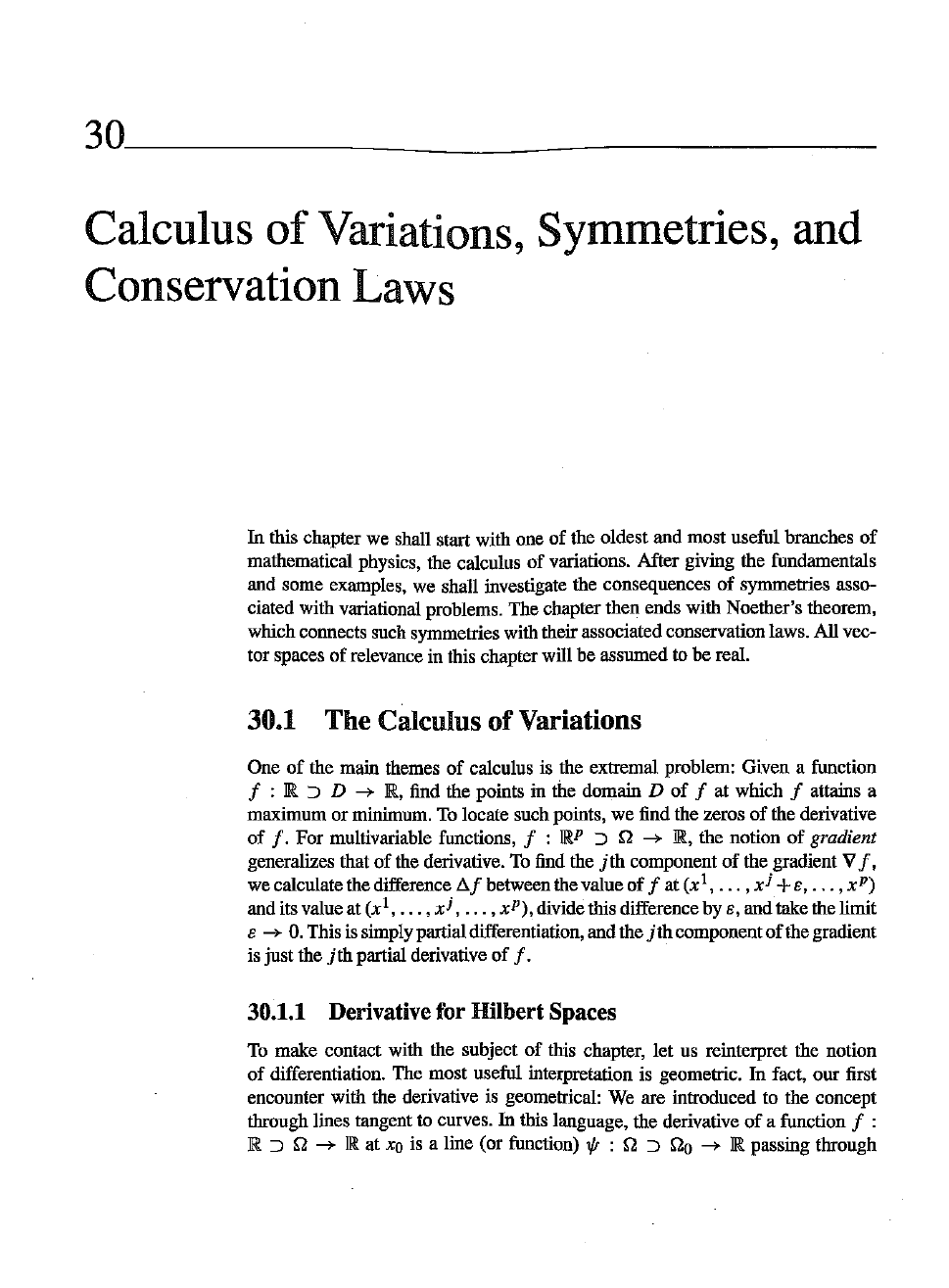
30
-------
Calculus
of
Variations,
Symmetries,
and
Conservation
Laws
In this chapter we shall start with one of the oldest and most nseful branches of
mathematical physics, the calcnlus of variations. After giving the fundamentals
and some examples, we shall investigate the consequences of symmetries asso-
ciated with variatioual problems. The chapter then ends with Noether's theorem,
which counects such symmetries with their associated conservation laws. All vec-
tor spaces of relevance in this chapter will be assumed to be real.
30.1 The Calculusof Variations
One
of
the main themes of calculus is the extremal problem: Giveu a function
1 :
IR
:J D -+
IR,
find the points iu the domain D of 1 at which 1 attains a
maximum or minimum. To locate such points, we find the zeros of the derivative
of
I. For multivariable functions, 1 :
IRP
:J n
-+
IR,
the notion of gradient
generalizes that
of
the derivative. To find the
jth
component
of
the gradient
VI,
we calcnlate the difference
1'>.1
between the value of 1at
(xl,
...
,x
j
+8,
...
,x
P)
and its value at
(xl,
...
,
xl
,
...
, x
P),
divide this difference by
8,
and take the limit
8 -+
O.
This is simplypartialdifferentiation, and the
jth
component
of
the gradient
is justthe
jth
partial derivative of I.
30.1.1 Derivativefor Hilbert Spaces
To make contact with the subject of this chapter,
let
us reinterpret the notion
of differentiation. The most useful interpretation is geometric. In fact, our first
encounter with the derivative is geometrical: We are introduced to the concept
through lines tangent to curves.
In this language, the derivative
of
a function 1 :
IR
:J
n
-+
IR
at
Xo
is a line (or function)
'"
: n
:J
no
-+
IR
passing through
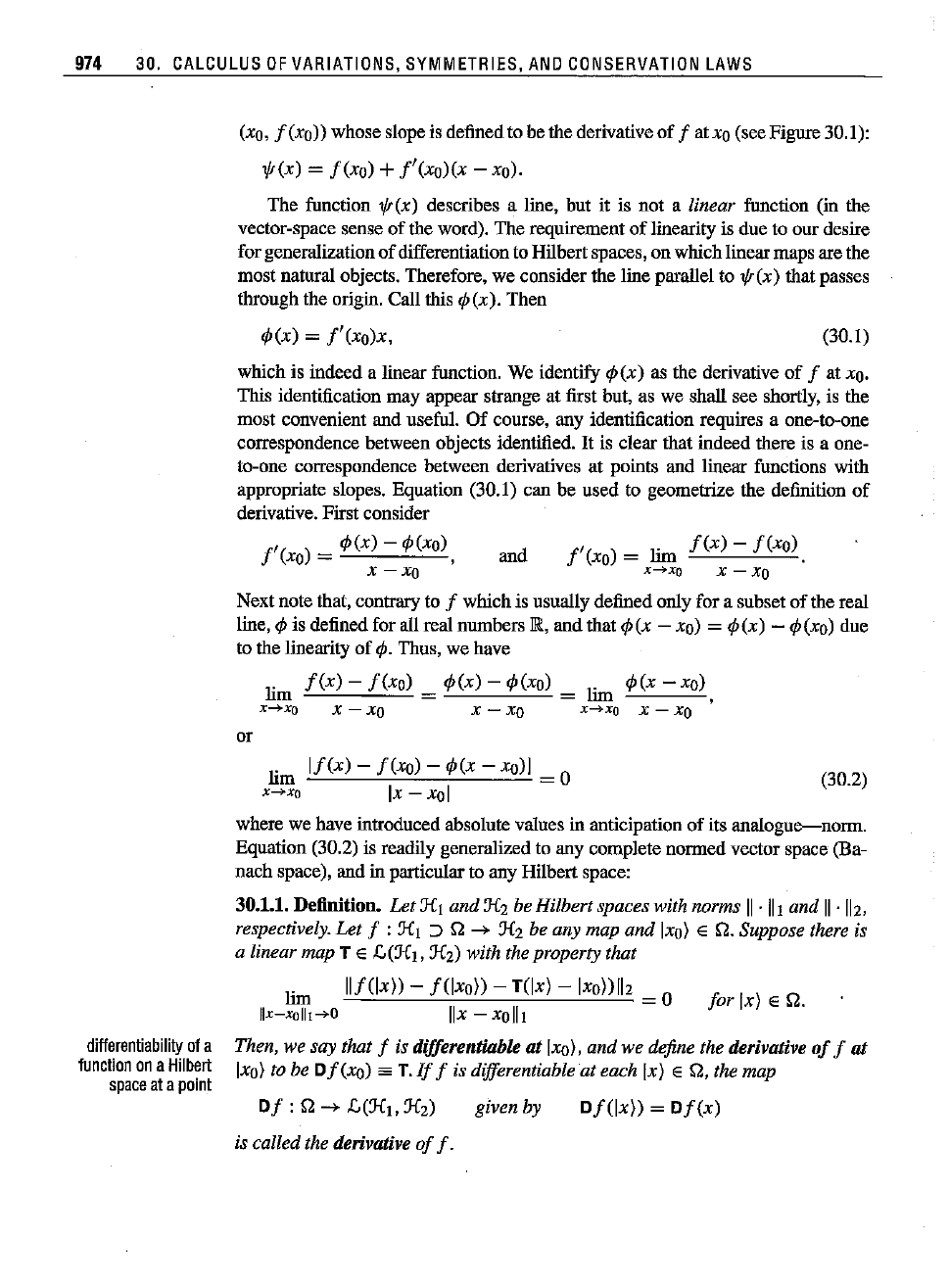
974
30.
CALCULUS
OF
VARIATIONS, SYMMETRIES,
AND
CONSERVATION
LAWS
(xo,
f(xo))
whose slope is definedto be the derivative
of
f
atxo
(see Figure 30,1):
1fJ(x)
=
f(xo)
+
f'(xo)(x
- xo).
The function
1fJ
(x) describes a line, but it is
not
a linear function (in the
vector-space sense
of
the word).
The
requirement
of
linearity is
due
to
our
desire
for generalization
of
differentiation to Hilbert spaces, on whichlinearmaps are the
most
natural objects. Therefore, we consider the line parallel to
1fJ
(x) that passes
through the origin. Call this '" (x). Then
"'(x)
=
!'(xo)x,
(30.1)
which is indeed a linear function, We identify
"'(x)
as the derivative
of
fat
xo.
This identification may appear strange at first but, as we shall see shortly, is the
most convenient anduseful. Of course, any identification
requires
a one-to-one
correspondence between objects identified.
It
is clear that indeed there is a one-
to-one correspondence between derivatives at points and linear functions with
appropriate slopes. Equation (30.1) can be used to geometrize the definition
of
derivative. First consider
f
'( ) -
"'(x)
- "'(xo)
xo
- ,
x
-xo
and
f'(xo)
=
lim
f(x)
-
f(x
o).
x~xo
X -
xo
Nextnote that, contrary to f whichis usually defined only for a subset
of
the real
line, '" is defined for all real numbers
rn;"
and
that
"'(x
- xo) =
"'(x)
- "'(xo) due
to the linearity
of
"'. Thus, we have
lim
f(x)
-
f(xo)
=
"'(x)
- "'(xo) =
lim
"'(x
- xo)
X--+XQ x -
XQ
x -
XQ
X--+XQ X - xo '
or
(30.2)
lim
If(x)
-
f(xo)
-
"'(x
-
xo)1
= 0
X-->Xo
Ix - XoI
where we have introduced absolute values in anticipation
of
its
analogue-norm.
Equation (30.2) is readily generalized to any complete normed vector space (Ba-
nach
space), and in particnlar to any Hilbert space:
30.1.1. Definition. Let
Jf
I and Jf2 be Hilbert spaces with norms
II
. IIIand
II
.
112,
respectively.
Let
f :
Jfl
:J
Q --* Jf2 be any map
and
Ixo) E
Q.
Suppose there is
a linear map
T E
£.(Jfl,
J(2)
with the property that
for
Ix) E
Q.
Df(lx))
=
Df(x)
given by
lim
IIf(lx}) -
f(lxo))
- T(lx) - I
xo))112
= 0
IIx-xo
II
1-->0
IIx
- xolll
Then, we say that f is differentiable at
Ixo},
and we define the derivative
of
f at
Ixo}
to be
Df(xo)
ea T.
If
f is differentiable at each Ix) E
Q,
the map
differentiability
ofa
function
on
a
Hilbert
space
ata
point
is called the derivative
of
f.
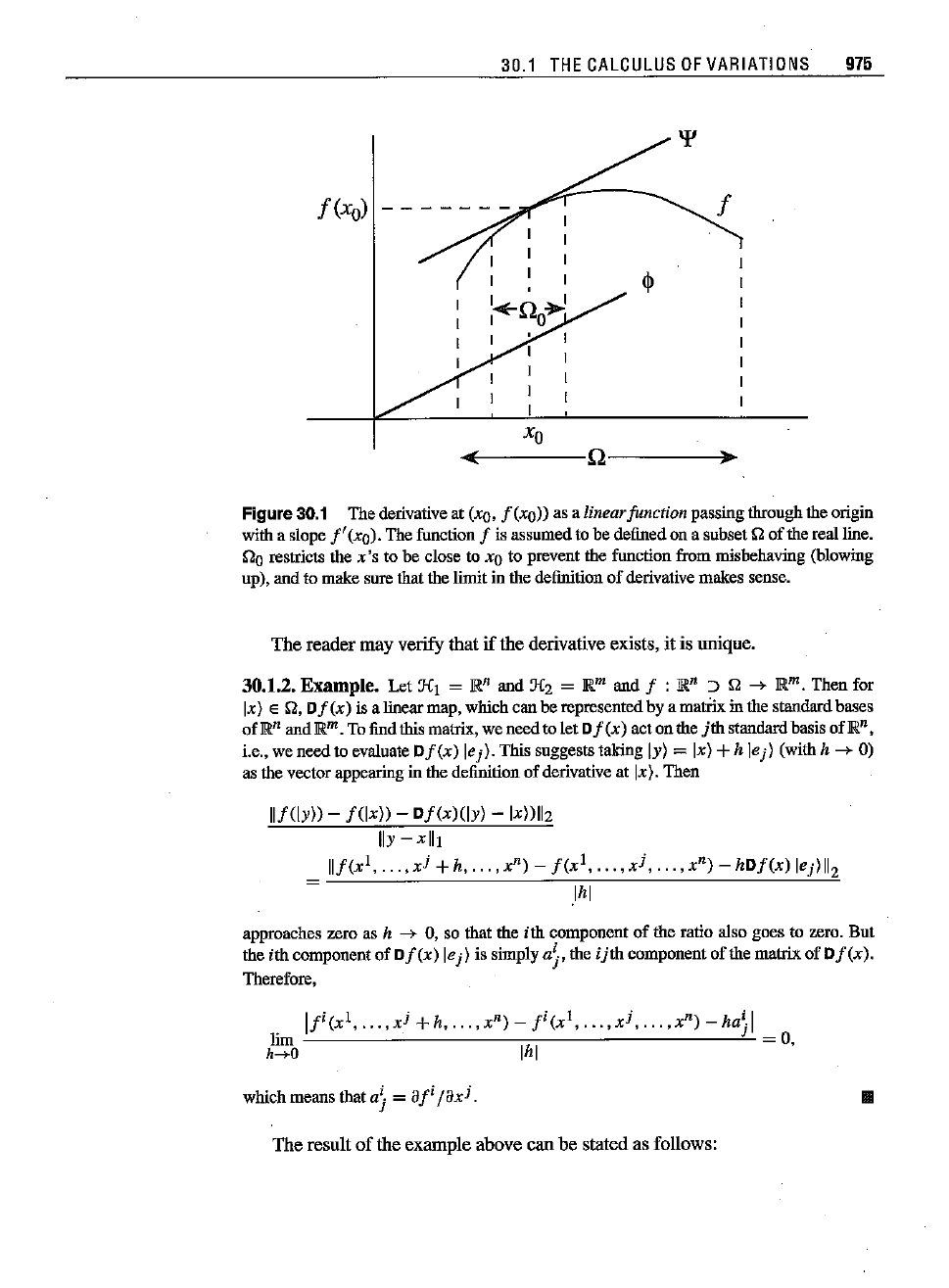
30.1
THE
CALCULUS
OFVARIATIONS 975
!
!(xo)
- - - - - - -
~---Q-----iIo-
Figure30.1 The
derivative
at
(xQ.
f
(xo»
asalinearfunctionpassing
through
theorigin
with
aslope
j'(xo).
The
function
f is
assumed
tobedefined on a
subset
{2
of
the real line.
00
restricts
thex's tobe close to XQ to
prevent
thefunction frommisbehaving (blowing
up),andto
make
sure
that
thelimitinthe
definition
of
derivative
makes
sense.
The
reader
may
verify
that
if
the
derivative exists, it is unique.
30.1.2.
Example.
Let 1f1 =
lll.n
and 1f2 =
lll.m
and f :
lll.n
:J n
-+
lll.m.
Then for
[z} E n,
Df(x)
is a linear map, which can be represented by a matrix in the standard bases
of
~n
and
IR
m
.Tofindthis
matrix,
weneedtoletDf (x) actonthe
jth
standard
basisofR"•
i.e.•weneed to evaluate
Df(x)
lei)'
Thissuggests taking Iy) =Ix)+h lei) (with h
-+
0)
asthe
vector
appearing
in the
definition
of
derivative
at
Ix}.
Then
IIf(ly»
-
f(lx»
-
Df(xHly)
-lx»)112
lIy
-xIII
IIf(x
l
,
...
,xi
+h,
...
,x
n)
-
f(x
l,
...
,
xi,
...
, x
n)
-
hDf(x)
lei)1I
2
Ihl
approaches zero as h
-+
0, so that the ith component
of
the ratio also goes to zero. But
the ith component of
Df(x)
lei) is simply
a~,
the
ijth
component of the matrix of
Df(x).
Therefore,
If
i ( l
i+h
n)
fill
i n)
hil
. x ,
...
,X
,
...
,X
- x "
..
,X
,
...
,X
- a
j
Iim h
=0,
h....O I I
which means that
a~
=a/
jax
i
.
III
The
result
of
the
example
above
can
be
stated
as follows:
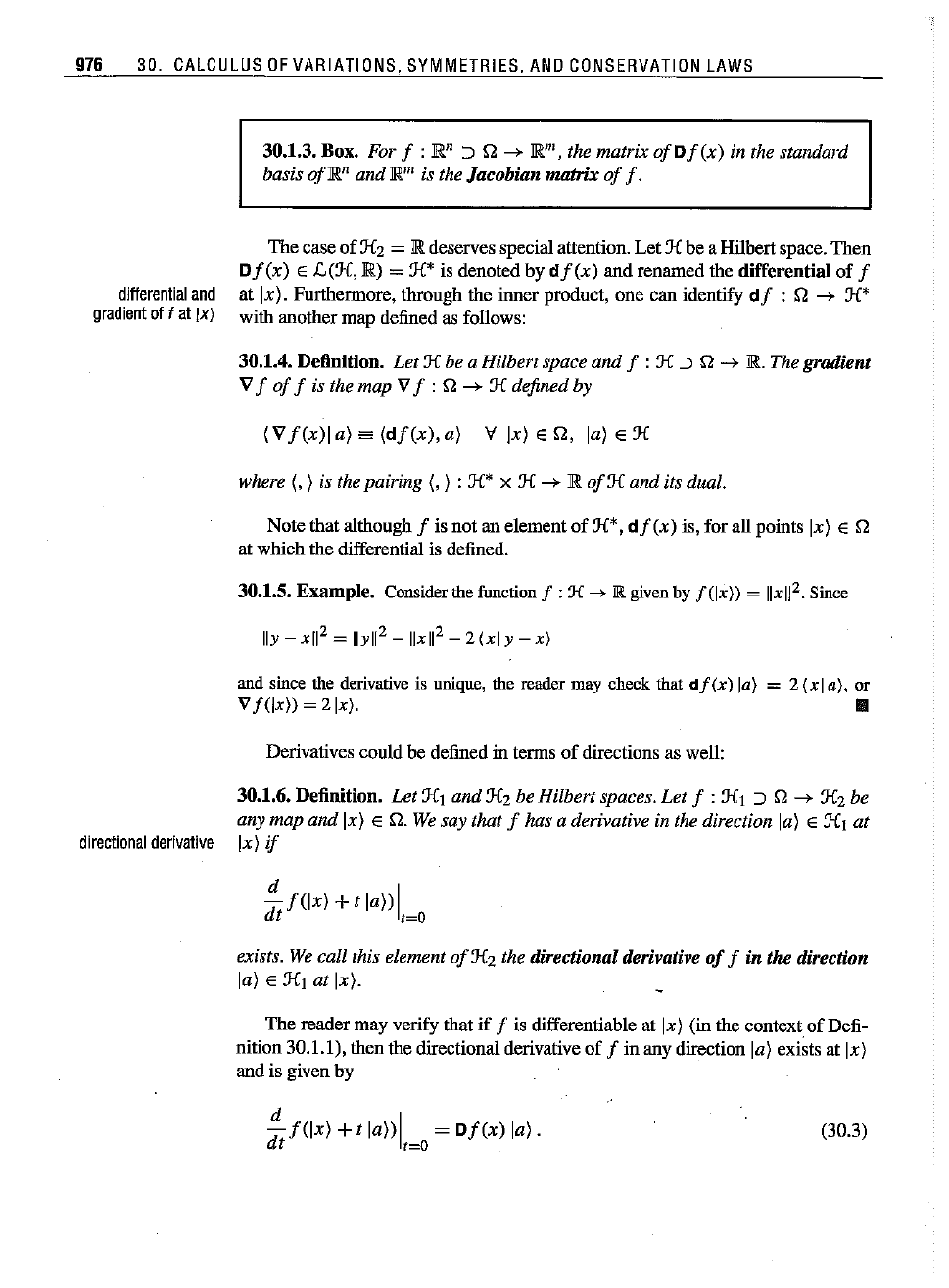
976 30.
CALCULUS
OF
VARIATIONS,SYMMETRIES,
ANO
CONSERVATION
LAWS
30.1.3.Box. For f : R" :J n
--+
R"', the matrix
of
Df (x) in the standard
basis
ofR"
and R'" is the Jacobian
matrix
of
f.
differential
and
gradient
off at Ix)
The case of:H2 = R deserves specialattention.
Let:H
be a Hilbert space. Then
Df(x)
E
£(:H,
R)
=:H*
is denoted by
df(x)
and renamed the differential of f
at
[x). Furtbennore, through the inner product, one can identify df : n
--+
:H*
with another map defined
asfollows:
30.1.4.Definition.
Let:H
be a Hilbert space
and
f : :H
:J
n
--+
R. The gradienl
V f
of
f is the map Vf : n
--+
:H defined by
(V
f(x)1
a)
'"
(df(x),
a) V Ix)
En,
10)
E:H
where (, ) is the pairing (, ) : :H* x :H
--+
R
of:H
and
its dual.
Note that although f is not an elementof:H*,
df(x)
is, for all points Ix} E n
at which the differential is defined.
30.1.5.
Example.
Consider the functionI :X
-+
rn:.
givenby
I(lx»
=
IIx
11
2
Since
lIy -
xll
2
= lIyll2
-lIxll
2
- 2
(xl
y -
x)
and since the
derivative
is unique, the reader may check that
d/(x)
10)
= 2 (x]a), or
V
1(lx))
= 2Ix). III
Derivatives could be defined in terms
of
directions as well:
30.1.6,Definition. Let:HI and:H2 be Hilbert spaces.
Let
f : :HI :J n
--+
:H2be
any map
and
Ix) E n.We say that f has a derivative in the direction
10)
E :HI at
directional
derivative
[x) if
exists. We call this element of:H2 the directional derivative
of
fin
Ihe direction
10)
E :HI at [x).
The reader may verify that
if
f is differentiable at [z) (in the contextof Defi-
nition 30.1.1), then the directional derivative of
f in any direction
10)
exists at Ix}
and is given by
!:.-
f(lx)
+I
lanl
=
Df(x)
10).
dt
,=0
(30.3)
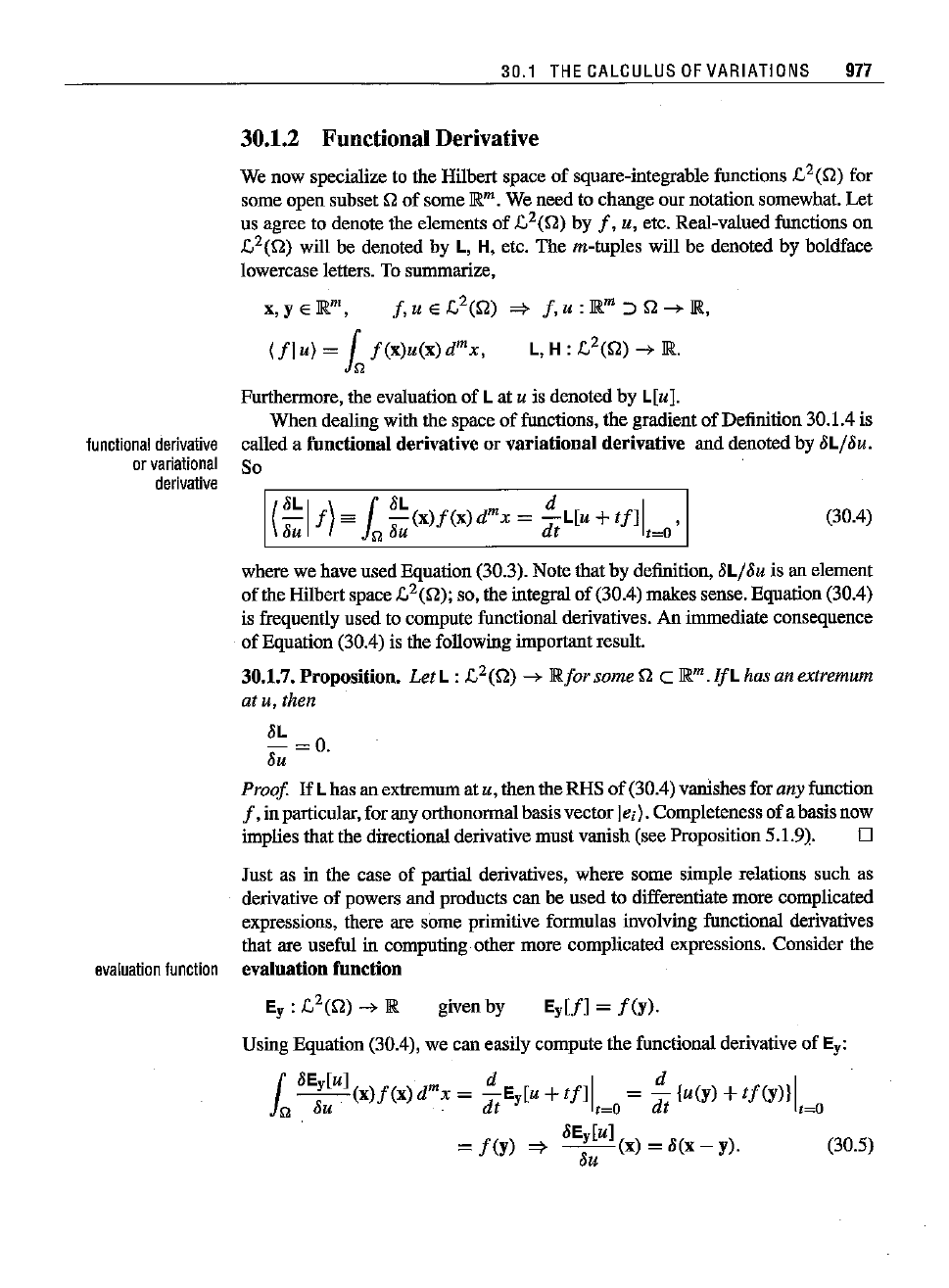
30.1
THE
CALCULUS
OF
VARIATIONS
971
30.1.2 Functional Derivative
We now specialize to the Hilbert space
of
square-integrable functions .c,2(Q) for
some open subset
Q
of
some
JRm.
We need to change our notation somewbat. Let
us agree to denote the elements
of
.c,2(Q) by
f,
u, etc. Real-valued functions on
.c,2(Q) will be denoted by L, H, etc. The m-tuples will be denoted by boldface
lowercase
letters.
To
summarize,
x, YE
JR
m,
f, u E .c,2(Q)
"*
f, u :
JRm
::>
Q
--+
JR,
UI
u) = 1f (x)u(x) dmx, L,H : .c,2(Q)
--+
JR.
Furthermore, theevaluation of Lat u is denoted by L[u].
When dealing with the space
of
functions, the gradient of Definition 30.1.4is
called a functional derivative or
variational
derivative and denoted by 8L/8u.
So
functional
derivative
or
variational
derivative
(
~
L
l
f
)
=
r
8L(x)f(x)
dmx =
dd
L[u+tfJl
'
uU
Jg
8u t 1=0
(30.4)
where we have used Equation (30.3). Note that by definition, 8L/8u is an element
of
the Hilbert space .c,2(Q); so, the integral of (30.4) makes sense. Equation (30.4)
is frequently used to compute functional derivatives. An immediate consequence
of
Equation (30.4) is the following important result.
30.1.7. Proposition. Let L : .c,2(Q)
--+
JRforsome Q C
JRm.
IfL
hasan extremum
at u, then
8L
-=0.
8u
Proof
If
Lhas an extremumat u, then the RHS
of
(30.4) vanishes for any function
f,
inparticular,for any orthonormalbasis vector lei). Completeness of abasis now
implies that the directional derivative must vanish (see Proposition
5.1.9). 0
Just as in the case of partial derivatives, where some simple relations such as
derivative of powers and prodncts can be used to differentiate more complicated
expressions, there are some primitive formulas involving functional derivatives
that are useful in computing other more complicated expressions. Consider the
evaluation
function
evalnation fnnction
given by Ey[fJ =
fey).
Using Equation (30.4), we can easily compute the functional derivative of E
y:
r8E;[U]
(x)f(x)
dmx =
dd
Ey[u +
tfJl
=
dd
luCY)
+
tf(y)}
I
)0.
uU t t=O t 1=0
8E [u]
=
fey)
"*
-y
-(x)
= 8(x - y). (30.5)
8u
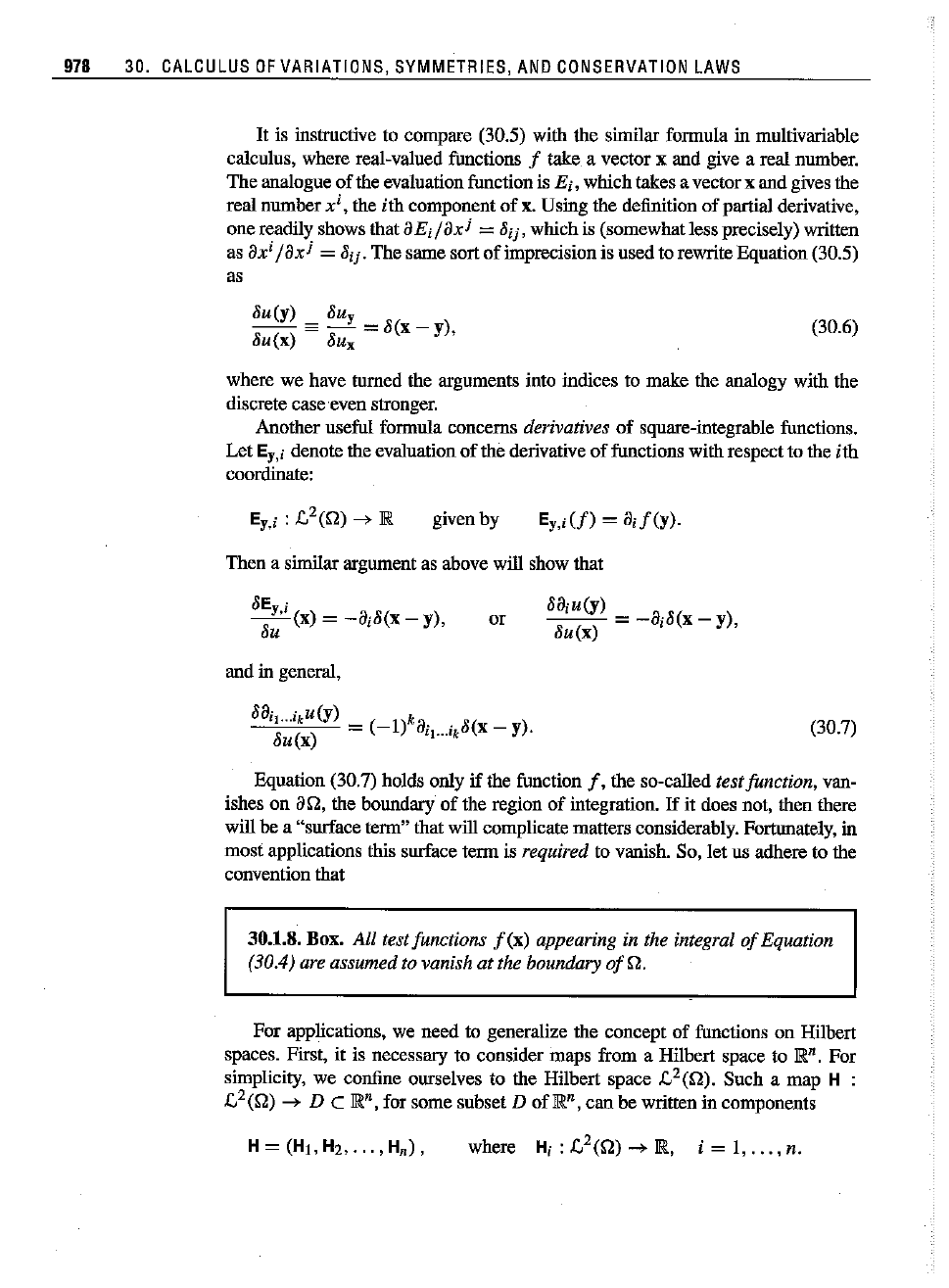
978
30.
CALCULUS
OF
VARIATIONS,SYMMETRIES,
AND
CONSERVATION
LAWS
It
is instructive to compare (30.5) with the similar formula in multivariable
calculus, where real-valued functions
f take a vector x and give a real number.
The
analogue
of
the evaluation function is Ei, whichtakes a vectorx
and
gives the
real number
xi,
the
ith
component
of
x.Using the definition
of
partial derivative,
one readily shows that
8E;/8x
i
= 8ij, which is (somewhatless precisely) written
as
8x
i
j8x
i
= 8ij. The same sort
of
imprecisionis used to rewrite Equation (30.5)
as
8u(y) 8u
y
--
==
- = 8(x - y),
8u(x) 8ux
(30.6)
where we have turned the arguments into indices to make the analogy with the
discrete
case
'even
stronger.
Another
useful
formula
concerns
derivatives of
square-integrable
functions.
Let
Ey,i denote the evaluation
of
the derivative
of
functions with respect to the
ith
coordinate:
given by
Ey,i
(f)
=
8;j(y).
Then a similar argument as above will show that
8E
y
i
--'
(x) =
-8i8(X
- y),
8u
and in general,
or
88i
U
(y)
8u(x) =
-8i
8(X
- y),
(30.7)
88il...i,U(y) =
(-1)k8'
. 8(x _ ).
8u(x)
'I
..·" y
Equation (30.7) holds only
if
the function
f,
the so-called test function, van-
ishes on
8rl,
the boundary
of
the region
of
integration.
If
it does not, then there
will be a "surface term" that will complicate matters considerably. Fortunately, in
most
applications this surface term is required to vanish. So, let us adhere to the
convention
that
30.1.8.Box.
All
test functions
f(x)
appearing in the integral
of
Equation
(30.4) are assumedto vanish at the boundary
ofrl.
For applications, we
need
to generalize the concept
of
functions on Hilbert
spaces. First, it is necessary to consider maps from a Hilbert space to
JR".
For
simplicity, we confine ourselves to the Hilbert space .c,2(rl).
Such
a map H
.c,2(rl) --> D C
JR",
for some subset D
of
JR",
can
be written in components
where
Hi:
.c,2(rl) -->
JR,
i = I,
...
, n.
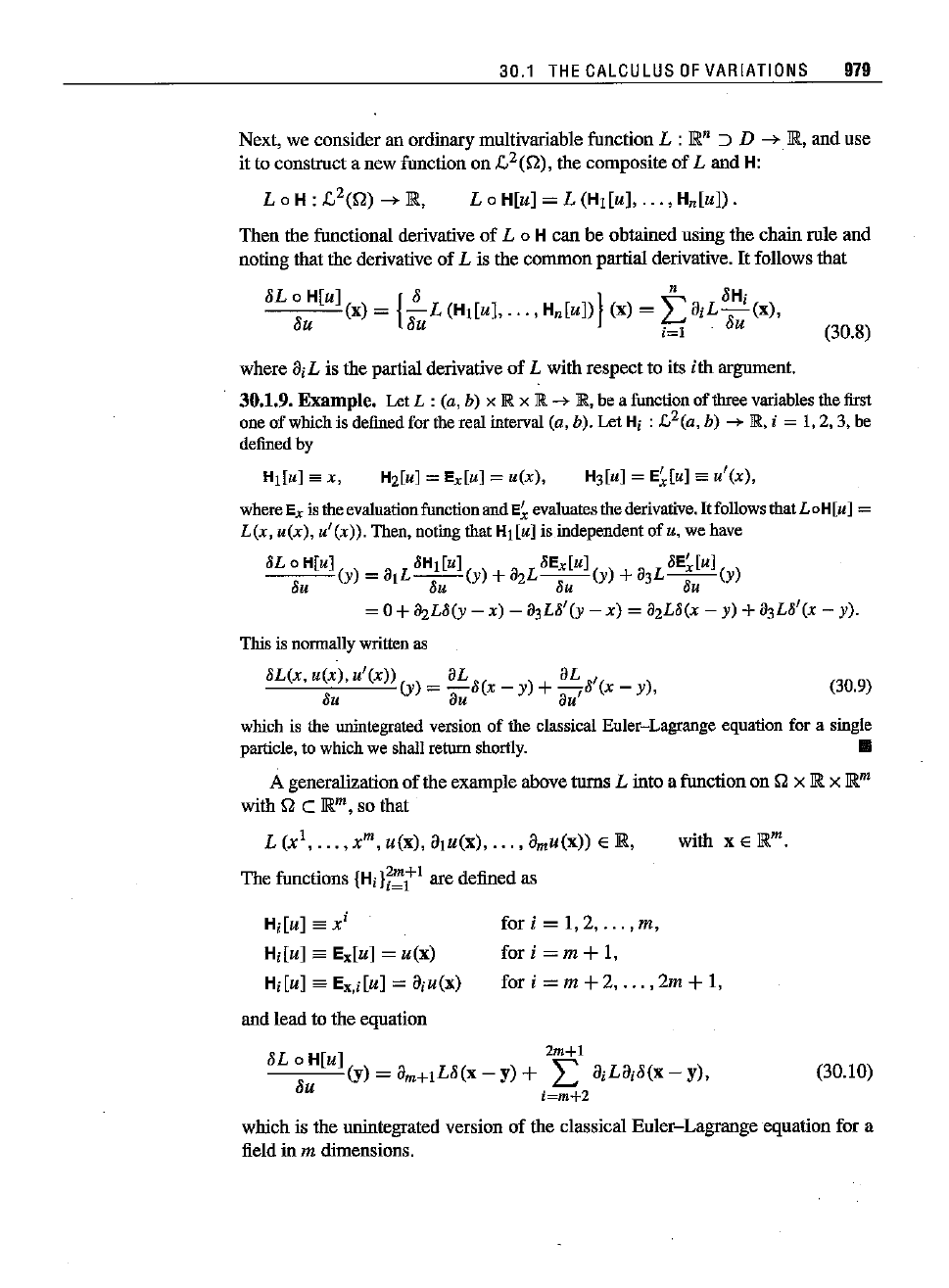
30.1 THECALCULUS
OF
VARIATIONS 979
Next, we consider an ordinary multivariable function L :
IR!.n
::J D
-->
IR!.,
and use
it
to construct a new function on ,(,2(\1), the composite
of
Land
H:
La
H : ,(,2(\1) -->
IR!.,
La
H[u] = L (HI[U],
...
,
Hn[u]).
(30.8)
Then the functional derivative
of
L a H
can
be
obtained using the chain rule and
noting that the derivative
of
L is the
common
partial derivative. It follows that
~L
a H[u] Is } n
~Hi
-::-"-"(x)
=
-L
(HI[U],
...
, Hn[u]) (x) =
I)iL-(X),
~U ~U
i=1 .
~U
where aiL is the par1ial derivative
of
L with respect to its
ith
argument.
30.1.9.
Example.
Let L : (a, b) x Ill.x Ill.
-+
R, be a functionof threevariablesthefirst
oneof whichis definedfor thereal interval
(a, b). Let Hi :
£}(a,
b)
-+
Ill.,i =
1,2,3,be
definedby
H2[U]
= Ex[u] =
u(x),
(30.9)
where
Ex
istheevaluationfunction andei
evaluates
the
derivative.
Itfollows
that
L
oH[u]
=
L(x,
u(x),
u'(x)).
Then,notingthat
HI[U]
is independent
ofu,
we have
8L a
H[u]
8HI[u] 8E
x[u]
8E~[u]
8u (y) =
oIL~(y)
+
02L~(y)
+
03L~(y)
= 0 +BzL8(y - x) -
03H'
(y -
x)
=
02H(X
- y) +
03H'(X
- y).
Thisis normally
written
as
8L(x,
u(x),
u'(x))
()
az'( )+ az,,( )
y =
-0
x - y
-0
x - y ,
Bu
au
au'
which
is the
unintegrated
version
of the classical
Euler-Lagrange
equation
fora single
particle,to whichwe shallreturn shortly.
..
A generalization
of
the example above
toms
L into a function on \1 x
IR!.
x
IR!.m
with \1 C
IR!.m,
so that
L
(xl,
...
, x
m,
u(x),
aIU(X),
...
, amu(x)) E
IR!.,
The functions {Hi
17:t
l
are defined as
fori = 1,2,
...
,m,
for i = m +
I,
for i = m +2,
...
,2m +I,
Hi[U]
==
xi
Hi[U] sa Ex[u] =
u(x)
Hi[U] sa Ex,i[U] =aiU(X)
and lead to the equation
~L
a H[u]
2m+1
_-::--=--.:c(y) =
am+IL~(x
- y) + L
aiLai~(X
-
y),
Bu
i=m+2
(30.10)
which is the unintegrated version
of
the classical Euler-Lagrange equation for a
field in
m dimensions.
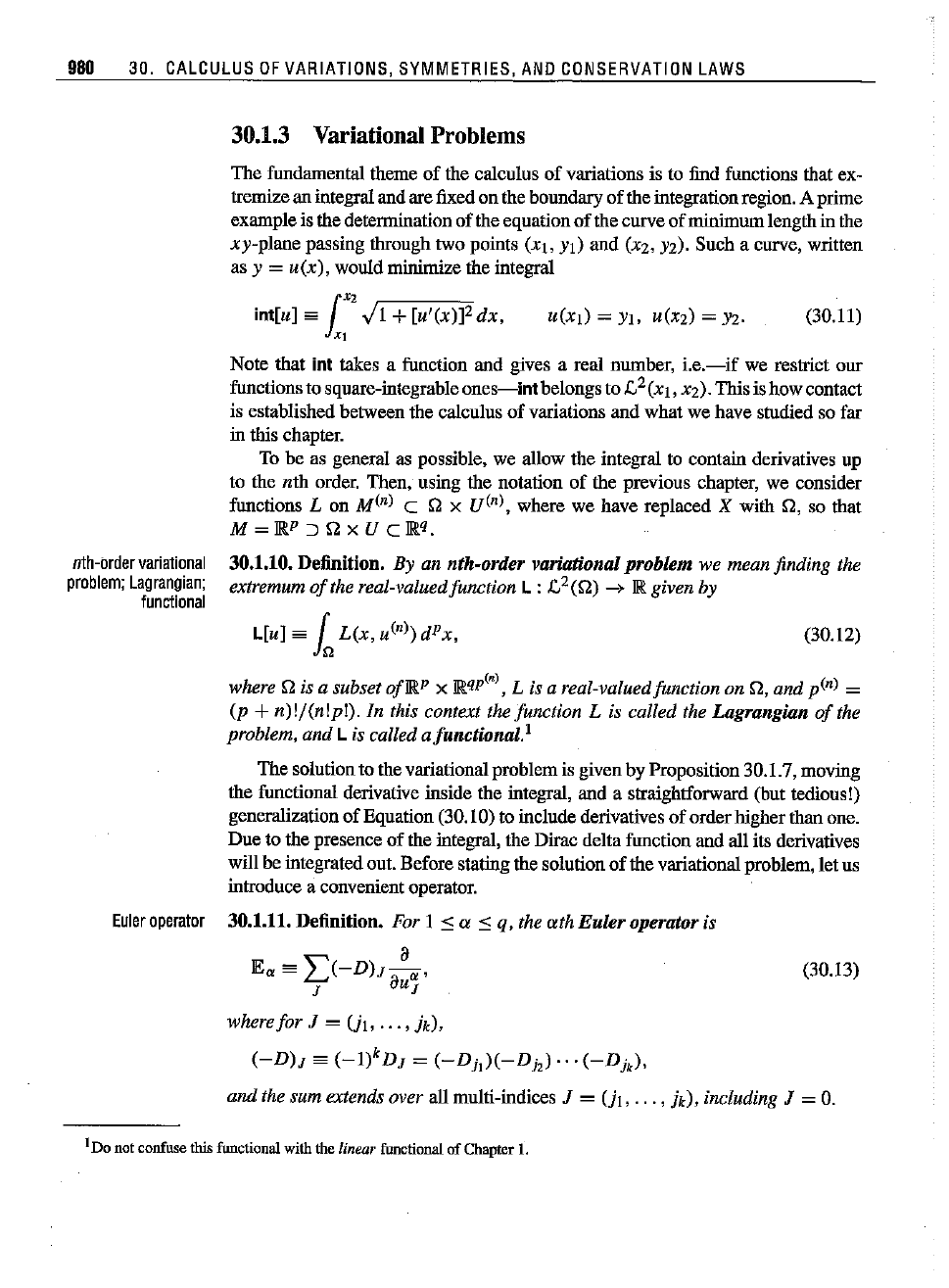
980 30.
CALCULUS
OF
VARIATIONS, SYMMETRIES,
AND
CONSERVATION
LAWS
30.1.3 Variational Problems
(30.11)
U(XI) =YI, U(X2) =Y2·
The
fundamental theme
of
the calculus
of
variations is to find functions that ex-
tremizean integraland are fixed on the boundary
of
the integrationregion. A prime
exampleis the determination
of
the equation
of
the curve
of
minimumlengthin the
xy-plane passing through two points
(XI,
Yl)
and (X2, Y2). Such a curve, written
as
Y = u
(x),
would minimize the integral
l
x2
Int[u] sa JI+
[u'(x)]2dx,
xr
(30.12)
nth-order
variational
problem;
Lagrangian;
functional
Note that int takes a function and gives a real number,
i.e.-if
we restrict our
functions to square-integrable
ones-intbelongs
to ,c2(XI, X2).Thisis how contact
is established between the calculus
of
variations and what we have studied so far
in this chapter.
To be as general
as possible, we allow the integral to contain derivatives up
to the
nth
order. Then, using the notation
of
the previous chapter, we consider
functions
L on
MCn)
cOx
U
Cn),
where we have replaced X with
0,
so that
M = jRP ::J 0 x U C
jRq.
30.1.10.Definition. By an nth-order variational problem we mean finding the
extremum
of
the real-valuedfunction L :
,c2(0)
-+
jRgiven by
L[u] sa
in
L(x,
uCn»)
dPx,
(30.13)
where 0 is a subset ofjRP x
jRqp(n),
L is a real-valuedfunction on
0,
and
pCn)
=
(p +n)!j(n!p!). In this context the function L is called the Lagrangian
of
the
problem,
and
L is called afunctional.I
The solutionto the variationalproblemis givenby Proposition30.1.7, moving
the functional derivative inside the integral, and a straightforward (but tedious!)
generalization
of
Equation (30.10) to include derivatives
of
orderhigherthan one.
Due
to the presence
of
the integral, the Dirac delta function and all its derivatives
will be integrated out. Before stating the solution
of
the variational problem, let us
introduce a convenient operator.
Euler
operator
30.1.11.Definition. For I
:s:
a
:s:
q, the ctth
Euler
operator is
a
lEa=L(-DlJ
a
a'
J
uJ
where
for
J =
(ii,
...
,
AJ,
(-D)J
sa
(-I)kDJ
=
(-Dh)(-Dj,)'"
(-DA),
and the sum extends over all multi-indices J = (iI,
...
,
ik),
including J =
O.
1Do not confuse this functional with the linear functional of Chapter 1.
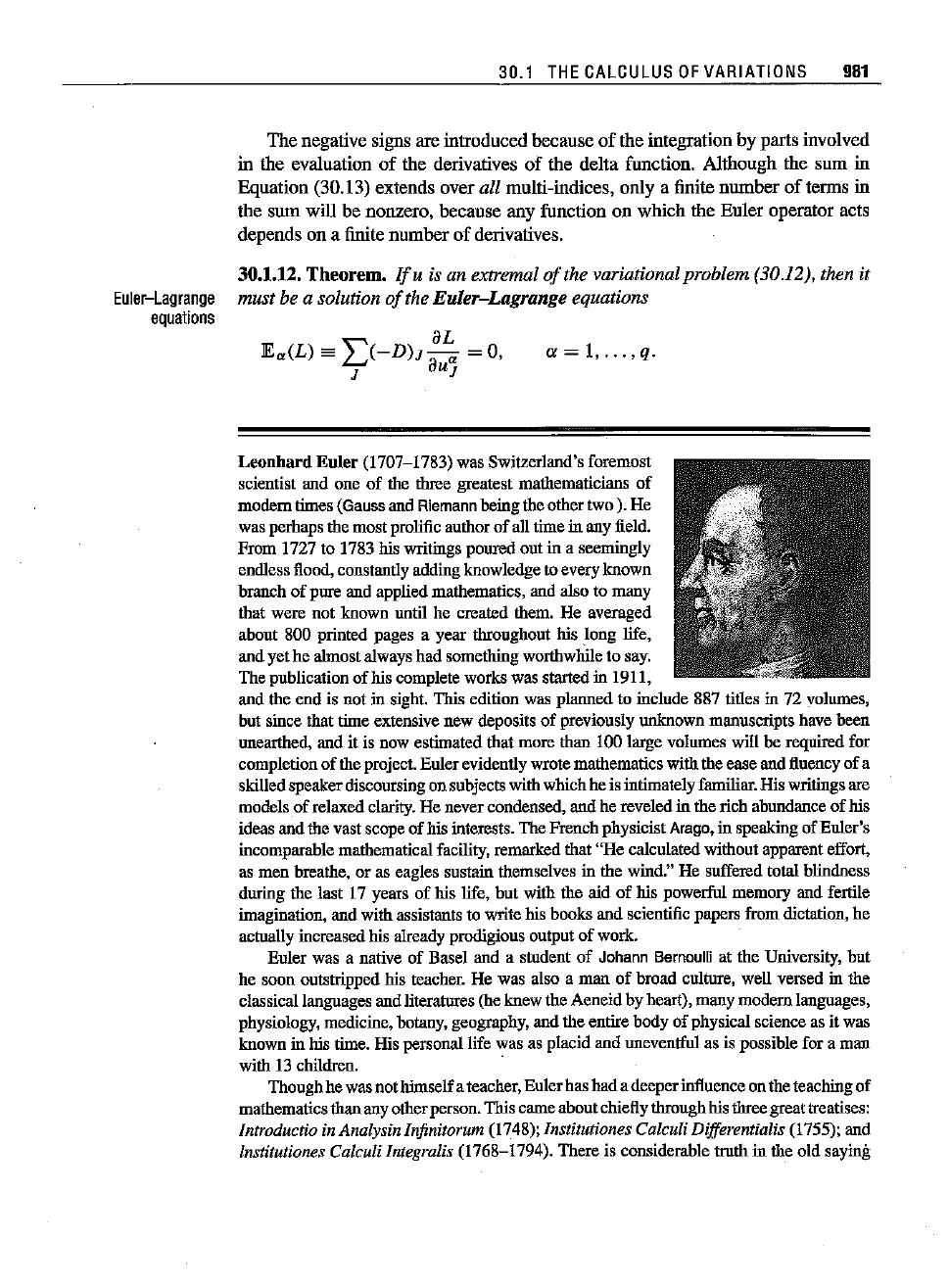
Euler-Lagrange
equations
30.1
THE
CALCULUS
OF
VARIATIONS
981
The
negative signs
are
introduced
because
of
the
integration
by
parts
involved
in
the
evaluation
of
the
derivatives
of
the
delta
function.
Although
the
sum
in
Equation
(30.13)
extends
over
all multi-indices,
only
a finite
nmnber
of
terms
in
the
sum
will
be
nonzero,
because
any
function
on
which
the
Euler
operator
acts
depends
on
a finite
number
of
derivatives.
30.1.12.
Theorem.
If
u is an extremal
of
the variational problem (30.12), then it
must be a solution
of
the Euler-Lagrange equations
ex
= 1,
...
,q.
Leonhard
Euler
(1707-1783) was Switzerland's foremost
scientist and one of the three greatest mathematicians of
modem
times (Gauss and Riemann beingthe other
two).
He
was perhaps the most prolific author
of
all time in any field.
Fram 1727 to 1783 his writings poured out in a seemingly
endless flood, constantly adding knowledge to every
known
branch of pure and applied mathematics, and also to many
that were not known until he created them. He averaged
about 800 printed pages a year throughout his Iong life,
and yet he almostalways
had
something worthwhile to say.
The publication
of
his complete works was started in 1911,
and the end is not in sight. This edition was planned to include 887 titles in 72 volumes,
but since that time extensive new deposits
of
previously unknown manuscripts have been
unearthed, and it is now estimated that more than
100 large volumes will berequired for
completion
of
the project.
Euler
evidently wrotemathematics with the ease and fluency
of
a
skilledspeakerdiscoursing on subjectswith whichhe is intimatelyfamiliar.
His
writingsare
models
of
relaxed clarity. He never condensed, and he reveledin the rich abundance
of
his
ideas and the vast scope
of
his interests. The Frenchphysicist Arago, in speaking of Euler's
incomparable mathematical facility, remarked that
"He
calculated without apparent effort,
as
men
breathe, or as eagles sustain themselves in the wind." He suffered total blindness
during the last 17 years of his life, but with the aid of his powerful memory and fertile
imagination, and with assistants to write his books and scientific papersfrom dictation, he
actually increased his already prodigious output
of
work.
Euler
was a native
of
Basel and a student
of
Johann
Bernoulli
at the University, but
he soon outstripped his teacher. He was also a
man
of
broad culture, well versed in the
classica11anguages and literatures (he knew the Aeueid by heart), many madera languages,
physiology, medicine, botany, geography, and the entire
body
of physical science as it was
known in his time. His personal life
was
as placid and uneventful as is possible for a
man
with 13 childreu. .
Thoughhe was not himselfa teacher,Eulerhas
had
a deeperinfluenceon the teaching
of
mathematicsthanany otherperson.Thiscame aboutchiefly throughhis threegreattreatises:
Introductio in AnalysinInfinitorum (1748); Institutiones Calculi Differentialis (1755); and
lnstitutiones Calculi Integralis (1768-1794). There is considerable truth in the old saying

982 30.
CALCULUS
OF
VARIATIONS, SYMMETRIES,
AND
CONSERVATION
LAWS
that all elementary and advanced calculus textbooks since 1748 are essentially copies
of
Euler or copies
of
copies
of
Euler.
These
works summed up and codified the discoveries
of
his predecessors, and are
full
of
Euler's own ideas. He extended and perfected plane
and solid analytic geometry, introduced the analytic approach to trigonometry, and was
responsible for the modem treatment of the functions In x and e", He created a consistent
theory
of
logarithms of negative and imaginary numbers. and discovered that Inx has an
infinite number
of
values. It was through his work that the symbols e. 1C. and i = J=T
became
common
currencyfor all mathematicians, and itwas he who linkedthem together in
the astonishing relation e
in
=
-1.
Among
his othercontributions to standardmathematical
notation were sin x,
cosx,
the use
of
f(x)
for an unspecified function, and the use
of
L
for summation.
His work in all departments
of
analysis strongly influenced the further development
of
this subject through the next two centuries. He contributed many importantideas to differ-
ential equations, including substantial parts
of
the theory
of
second-order linear equations
and the method
of
solution by 'power series. He gave the first systematic discussion
of
the
calculus
of
variations, whichhe founded on his basic differentialequationfor a minimizing
curve. He discovered the integral defining the
gamma
function and developed many
of
its
applications and special properties. He also worked with Fourier series, encountered the
Bessel functions in his study
of
the vibrations
of
a stretchedcircularmembrane, and applied
Laplace transforms to solve differential
equations-all
before Fourier, Bessel, and Laplace
werebom.
E. T. Bell, the well-known historian
of
mathematics, observed that
"One
of
the
most
remarkable features
of
Euler's universal genius was its equal strength in both
of
the main
currents
of
mathematics, the continuous and the discrete." In the
realm
of
the discrete, he
was one
of
the originators
of
number
theory and
made
many far-reaching contributions to
this subject throughout his life.
In addition, the origins
of
topology-cone
of
the dominant
forces
in
modem
mathematics-lie
in his solution
of
the Konigsberg bridge problem and
his formula
V - E + F = 2 connecting the numbers
of
vertices, edges, and faces
of
a
simple polyhedron.
The
distinction between pure and applied mathematics did not exist in Euler's day, and
for
him the entire physical universe was a convenient object whose diverse phenomena
offered scope for his methods
of
analysis. The foundations of classical mechanics had
been laid down by Newton,but
Euler
was the principal architect. In his treatise
of
1736 he
was the first to explicitly introduce the concept
of
a mass-point, or particle, and he was
also the first to study the acceleration
of
a particle moving along any curve and to use the
notion
of
a vector in connection with velocity and acceleration. His continued successes
in mathematical physics were so numerous, and his influence was so pervasive, that
most
of
his discoveries are not credited to
him
at all and are taken for granted in the physics
community as part
of
the natural order
of
things. However, we do have Euler's angles for
the rotation
of
a rigid body, and the all-important Euler-Lagrange equation
of
variational
dynamics.
Euler
was the Shakespeare
of
mathematics-universal,
richly detailed, and inex-
haustible.
